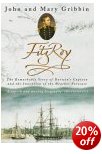 Robert FitzRoy's contribution to science, exploration and humanity was never fully acknowledged in his lifetime. Nor were the half million hand-written words he transcribed about his survey work and voyages. Being the Captain of HMS Beagle which carried amongst its scientific crew the young, Charles Darwin, Fitzroy's work, when published was dwarfed by Darwin's Origin of the Species . It was as recently as 2002 that Fitroy was acknowledged for the invention and instigation of a weatherforcasting system - a system which at the time of its first presentation to British Parliament was received with laugher in the House.
Robert FitzRoy's contribution to science, exploration and humanity was never fully acknowledged in his lifetime. Nor were the half million hand-written words he transcribed about his survey work and voyages. Being the Captain of HMS Beagle which carried amongst its scientific crew the young, Charles Darwin, Fitzroy's work, when published was dwarfed by Darwin's Origin of the Species . It was as recently as 2002 that Fitroy was acknowledged for the invention and instigation of a weatherforcasting system - a system which at the time of its first presentation to British Parliament was received with laugher in the House.The boy sailor and marine luminescence
Born in 1805, like so many young gentlemen from artistocratic families, FitzRoy joined the Royal Navy at a very early age.
In 1818, at the tender age of only 13, he wrote a letter to his father.
It reads:
Last night when I was coming back, the boat I was in was going very quick, and I put my hand into the water and the little ripple of water it made Sparks, at least they looked exactly like it ... like from a flint and steel, and I could not make out what it was for the oars did the same...
He asks his father to write and tell him what it was he had seen.
FitzRoy and Sea Dust
It was during my first voyage on the tall ship, STS Leeuwin that I first witnessed marine bioluminescence.
I shall always remember the experience, sitting alone on bow watch in the early hours of the morning watching the tiny pin-pricks of light glittering in the sea, appearing and disappearing as if by magic.
I was amazed by the phenomenon and called the particles "illusive diamonds".
It was my "illusive diamonds" which inspired me to write my first novel, Sea Dust.
Reading the biography of FitzRoy by John and Mary Gribbin (2003), I felt an instant empathy for the boy sailor sitting in the small boat 200 years ago. I wanted to tell him I had marvelled at the sea's magic also.
Photo: FitzRoy by John and Mary Gribbin available from Amazon.uk.com
No comments:
Post a Comment